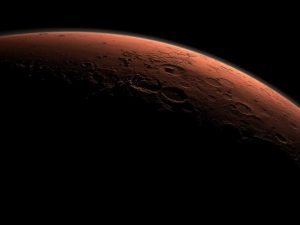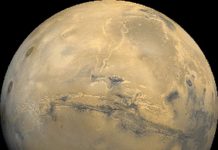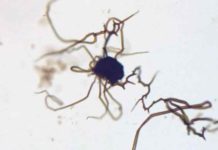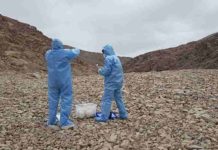
The bombardment of Mars some 4 billion years ago by comets and asteroids as large as West Virginia likely enhanced climate conditions enough to make the planet more conducive to life, at least for a time, says a new University of Colorado Boulder study.
CU-Boulder Professor Stephen Mojzsis said if early Mars was as barren and cold as it is today, massive asteroid and comet impacts would have produced enough heat to melt subsurface ice. The impacts would have produced regional hydrothermal systems on Mars similar to those in Yellowstone National Park, which today harbor chemically powered microbes, some of which can survive boiling in hot springs or inhabiting water acidic enough to dissolve nails.
Scientists have long known there was once running water on Mars, as evidenced by ancient river valleys, deltas and parts of lake beds, said Mojzsis. In addition to producing hydrothermal regions in portions of Mars’ fractured and melted crust, a massive impact could have temporarily increased the planet’s atmospheric pressure, periodically heating Mars up enough to “re-start” a dormant water cycle.
“This study shows the ancient bombardment of Mars by comets and asteroids would have been greatly beneficial to life there, if life was present,” said Mojzsis, a professor in the geological sciences department. “But up to now we have no convincing evidence life ever existed there, so we don’t know if early Mars was a crucible of life or a haven for life.”
Published in Earth and Planetary Science Letters, the study was conducted by Mojzsis and Oleg Abramov, a researcher at the U.S. Geological Survey in Flagstaff, Arizona and a former CU-Boulder research scientist under Mojzsis.
Much of the action on Mars occurred during a period known as the Late Heavy Bombardment about 3.9 billion years ago when the developing solar system was a shooting gallery of comets, asteroids, moons and planets. Unlike Earth, which has been “resurfaced” time and again by erosion and plate tectonics, heavy cratering is still evident on Mercury, Earth’s moon and Mars, Mojzsis said.
Mojzsis and Abramov used the Janus supercomputer cluster at the University of Colorado Computing facility for some of the 3-D modeling used in the study. They looked at temperatures beneath millions of individual craters in their computer simulations to assess heating and cooling, as well as the effects of impacts on Mars from different angles and velocities. A single model comprising the whole surface of Mars took up to two weeks to run on the supercomputer cluster, said Mojzsis.
The study showed the heating of ancient Mars caused by individual asteroid collisions would likely have lasted only a few million years before the Red Planet – about one and one-half times the distance to the sun than Earth – defaulted to today’s cold and inhospitable conditions.
“None of the models we ran could keep Mars consistently warm over long periods,” said Mojzsis.
While Mars is believed to have spent most of its history in a cold state, Earth was likely habitable over almost its entire existence. A 2009 study by Mojzsis and Abramov showed that the Late Heavy Bombardment period in the inner solar system nearly 4 billion years ago did not have the firepower to extinguish potential early life on Earth and may have even given it a boost if it was present.
“What really saved the day for Earth was its oceans,” Mojzsis said. “In order to wipe out life here, the oceans would have had to have been boiled away. Those extreme conditions in that time period are beyond the realm of scientific possibility.”
The new Mars study was funded by NASA and the John Templeton Foundation. Mojzsis recently received an $800,000 grant from the Foundation for Applied Molecular Evolution in Alachua, Florida made possible by the Templeton Foundation to better understand early Earth and the beginning of life before about 4 billion years ago.
“Studies of Mars provide us with valuable information about our own place in the solar system,” he said. “Our next steps are to model similar bombardment on Mercury and Venus to better understand the evolution of the inner solar system and apply that knowledge to studies of planets around other stars.”
Mojzsis will meet with scientists from the California Institute of Technology and NASA’s Jet Propulsion Laboratory in Pasadena next month to discuss possible landing sites and research targets for the upcoming Mars 2020 rover mission. Mars 2020 will carry instruments to seek out past life or present life, hunt for habitable areas and demonstrate technologies for use on future robotic and human missions to Mars.
Note: The above post is reprinted from materials provided by University of Colorado at Boulder.










